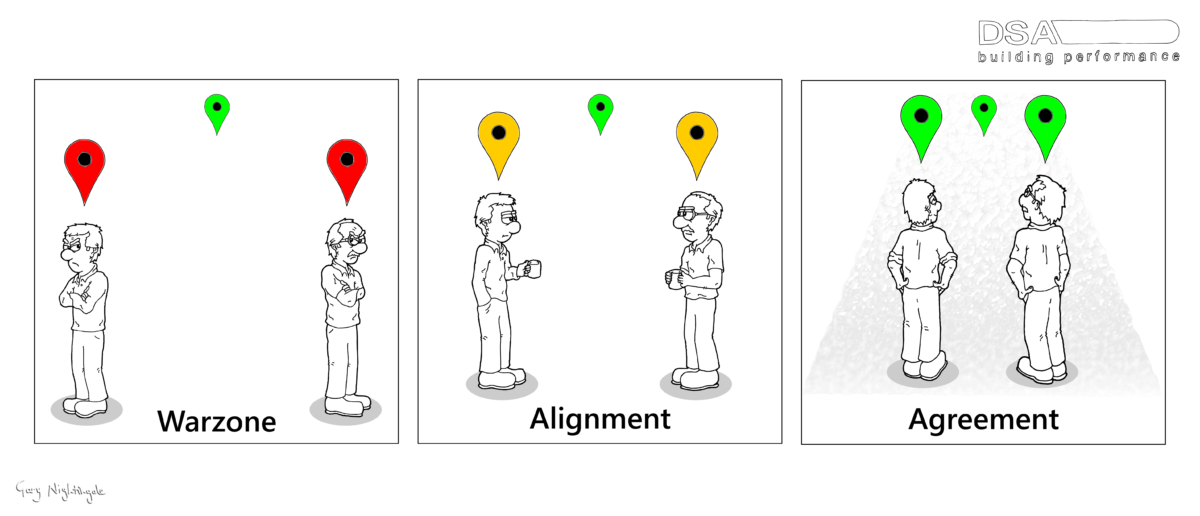The myth of “alignment”: it’s not enough

After a while, all the leadership teams I coach start talking about how well aligned they are.
That’s good, right? Yes, but more is needed.
They are pointing in the same direction. They’re on course to reap the multiplying benefits of their collective effort.
The state of being unaligned is usually what prompts the call to me.
“We are operating in silos,” is how the conversation starts. “We need to work together, collaborate, though I have tried everything and it hasn’t worked. We’re fighting and it’s getting worse. We need to do something about behaviours round here, and not just the client’s, it’s us as well.”
I know how to get people aligned. When you know how to do it, it’s easy.
The project was a war zone
I can get warring factions aligned in a one-day session.
For example, an exec rang and said he was taking over a long-running and troubled project.
There were years left, previously the client and contractor took each other to court. The settlement was millions.
“I have to turn this around,” he said.
In fact, one of the conditions of the settlement was that they had to “collaborate” from that point on.
He described the project as a war zone. I thought, no wonder: after a vicious dogfight, one party had paid out millions. History and baggage matter.
I asked him what options he was considering. He said they had just about lined up a big, ugly, smelly, hardnosed and very clever lawyer from London, and next time round they were going to win.
What would the other side do, I asked? He said they would probably get an even bigger, uglier, smellier and just as clever lawyer.
“That’s kind of why I called you, Dave,” he said. “We’re supposed to collaborate, but I’m not sure if it’s possible here. If we could just get some alignment going forward that would be a start.”
They wouldn’t even share a cup of tea
We set up a workshop between the key players from the client and contractor.
It was an eight-thirty ease-in for a nine o’clock start: bacon sandwiches and a cup of tea.
The two sides stood in opposite corners of the hotel foyer, making no eye contact across the space.
When they came into the conference room they sat in two separate groups. Still no eye contact, like it was a dentist’s waiting room.
But by lunch they were talking in mixed groups and after we finished they all went off to the pub for a few pints.
On the feedback sheets I collected at the end of the day, they said. “I can’t believe how well aligned we are now” and “We’re looking forward to the rest of the job together”.
Although some did say, “Time will tell”.
The exec rang me two days later: “Job done, thanks Dave.”
I remember thinking, “Yeah, right”. I knew time would tell, and it did.
The experience helped me realise that one-off workshops are not my bag.
Alignment is not agreement, and not enough
What happened on that day was basic ice-breaking. People from each side began behaving as colleagues, not enemies. They began to talk and listen to each other, and to appreciate that they shared the same overarching goals.
To me, aligned means ‘up for the direction of travel’, though not much more.
Still to come is complete agreement on each of the difficult, granular issues that crop up, which is hard, detailed work.
You can get alignment in a one-day workshop, but ongoing, productive collaboration requires more.
Alignment gets you started as a team, but it’s the painstaking work of reaching agreement along the way that counts.
Difficult conversations are needed, differences need to be integrated, and relationships need to be built and continually strengthened as the path to success steepens.
That’s what real collaboration looks like.
Beware of group think
Alignment is about positive mood and intentions.
As such, it can actually be a hindrance to real collaboration because it creates pressure to maintain the positive mood by ignoring difficulties.
Ignoring difficulties isn’t alignment, it’s group think.
In her book, Wilful Blindness, Margaret Heffernan, says “In most organisations, the good team player is implicitly defined as the person who goes along, not the one who asks hard questions”
I relate to that. I was always the one who asked the hard questions, a fully paid up member of the ‘awkward squad’.
Maybe it’s time we had some creative dissent on purpose.
Let’s hear it from the ‘awkward squad’, while at the same time holding a safe space for the conversations to be had – that’s the job of an experienced and professional coach. It’s what I do.

